Showing all 9 results
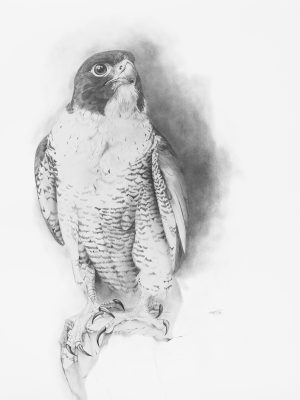
Peregrine falcon (Falco peregrinus)
All confirmed nests in Tasmania have been on cliffs. A site sheltered from heavy rain or high chill-factors is preferred and just a scrape is made to lay eggs.
Tasmania is a great place for peregrines but far from the best. The nesting population recovered from ravages of organochlorine pesticides in the 1960s, 1970s and into the 1980s, through legal protection in the early 1970s to now. With approximately 120 breeding pairs, the population has been relatively stable for some years now. Most are clustered in river valleys and along suitable coastline and on inshore islands and where close (< 4km apart) pairs tend to be evenly distributed due to their territorial nature. Nests are fiercely defended against all kinds of perceived threats and predators.
Size: A2 (59.4 cm x 42 cm). Printed on 310 gsm Museum quality art paper.
This is an archival print.
*Price includes postage anywhere within Australia
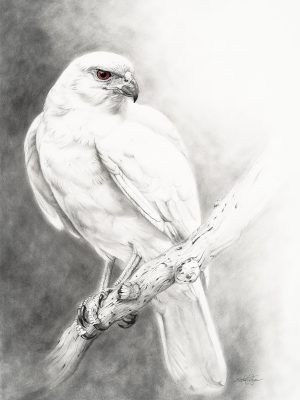
Grey goshawk - white morph (Accipiter novaehollandiae)
The grey morph has a pale grey head and back, dark wingtips, barred grey breast and tail, and white underparts. The white morph is the only bird of prey in the world to be entirely white.
Grey Goshawks are about 40–55 cm long, with wingspans of 70–110 cm. Females are much larger than males, weighing about 680 g. Males average 350 g.
Goshawks usually prey on mammals such as rabbits, possums, and bats. They may also eat birds, small reptiles, and insects. Females, due to their size, can catch larger prey than males.
Hunting is often done by stealth, and very successfully, but Grey Goshawks are willing to pursue their prey before catching it with their talons
Size: A2 (59.4 cm x 42 cm). Printed on 310 gsm Museum quality art paper.
This is an archival print.
*Price includes postage anywhere within Australia
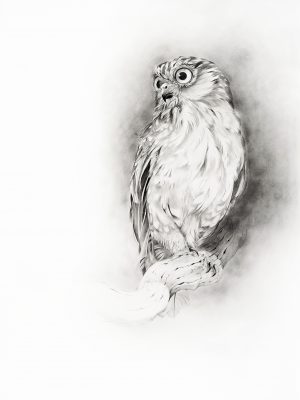
Southern Boobook owl (Ninox novaeseelandiae)
The Southern Boobook is the smallest and most common owl in Australia. It is identified by its plumage, which is dark chocolate-brown above and rufous-brown below, heavily streaked and spotted with white. The facial disc is chocolate brown and the eyes are large and yellowish. Tasmanian birds are smaller and more heavily spotted with white. Young Southern Boobooks are almost entirely buff-white below, with conspicuous dark brown facial discs. Like other owl species, the Southern Boobook is nocturnal.
Size: A2 (59.4 cm x 42 cm). Printed on 310 gsm Museum quality art paper.
This is an archival print.
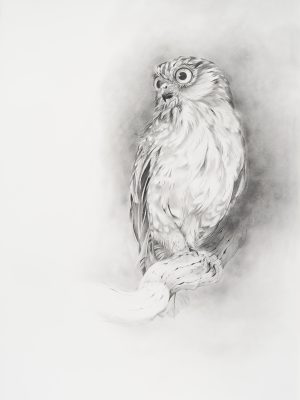
Southern Boobook owl (Ninox novaeseelandiae)
The Southern Boobook is the smallest and most common owl in Australia. It is identified by its plumage, which is dark chocolate-brown above and rufous-brown below, heavily streaked and spotted with white. The facial disc is chocolate brown and the eyes are large and yellowish. Tasmanian birds are smaller and more heavily spotted with white. Young Southern Boobooks are almost entirely buff-white below, with conspicuous dark brown facial discs. Like other owl species, the Southern Boobook is nocturnal.
This original piece is SOLD.
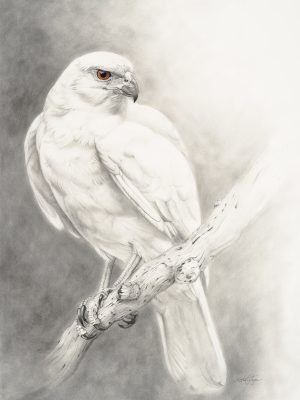
Grey goshawk - white morph (Accipiter novaehollandiae)
The grey morph has a pale grey head and back, dark wingtips, barred grey breast and tail, and white underparts. The white morph is the only bird of prey in the world to be entirely white.
Grey Goshawks are about 40–55 cm long, with wingspans of 70–110 cm. Females are much larger than males, weighing about 680 g. Males average 350 g.
Goshawks usually prey on mammals such as rabbits, possums, and bats. They may also eat birds, small reptiles, and insects. Females, due to their size, can catch larger prey than males.
Hunting is often done by stealth, and very successfully, but Grey Goshawks are willing to pursue their prey before catching it with their talons
This original piece is SOLD.
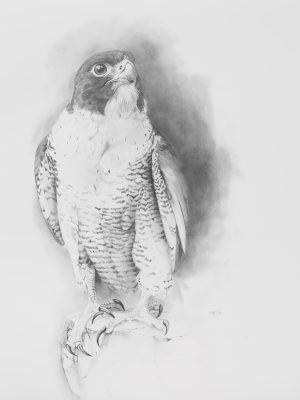
Peregrine falcon (Falco peregrinus)
All confirmed nests in Tasmania have been on cliffs. A site sheltered from heavy rain or high chill-factors is preferred and just a scrape is made to lay eggs.
Tasmania is a great place for peregrines but far from the best. The nesting population recovered from ravages of organochlorine pesticides in the 1960s, 1970s and into the 1980s, through legal protection in the early 1970s to now. With approximately 120 breeding pairs, the population has been relatively stable for some years now. Most are clustered in river valleys and along suitable coastline and on inshore islands and where close (< 4km apart) pairs tend to be evenly distributed due to their territorial nature. Nests are fiercely defended against all kinds of perceived threats and predators.
This original piece is SOLD.
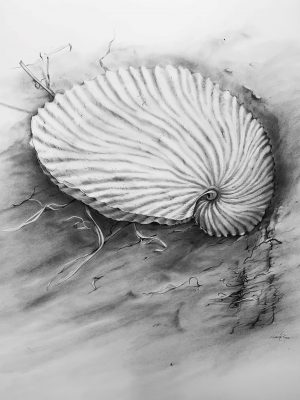
100 cm x 80 cm Framed. Graphite on 640 gsm hot press rag paper
The Argonaut, or paper nautilus, is actually a pelagic octopus. Females make a parchment-like shell (up to 30cm) which is used to carry incubating eggs and to trap surface air, which helps them maintain buoyancy.
This original piece is SOLD.
110 cm x 90 cm Graphite on 640 gsm hot press rag paper
The Aberdeen Angus, sometimes simply Angus, is a Scottish breed of small beef cattle. It derives from cattle native to the counties of Aberdeenshire and Angus in north-eastern Scotland. Angus cattle were first introduced to Tasmania (then known as Van Diemen's Land) in the 1820s and to the southern mainland in 1840. The breed is now found in all Australian states and territories, including King Island. With lush pastures and a temperate climate, the island is perfect for breeding the happiest, grass-fed cattle on the planet.
This original piece is SOLD. To view our limited edition prints click here.
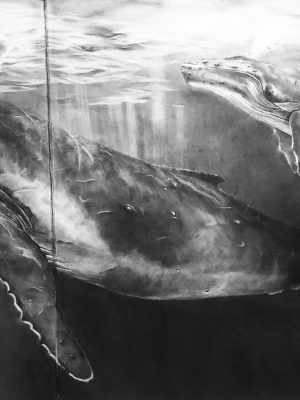
Graphite 1.2 metres x 2.5 metres
Humpback whale and calf (Megaptera novaeangliae)
Humpback whales are a baleen whale and are renowned for their spectacular 'breaching' behaviour. Most humpback whales make exceptionally long journeys every year between their feeding and breeding sites. Females typically breed every two or three years. The gestation period is 11.5 months. The peak months for birth are January, February (Northern Hemisphere), July and August (Southern Hemisphere). Females wait for one to two years before breeding again. Humpbacks can travel up to 8 km/h but during their long migration journey they average only 1.6km/h, resting and socialising along the way.
This original piece is SOLD.
